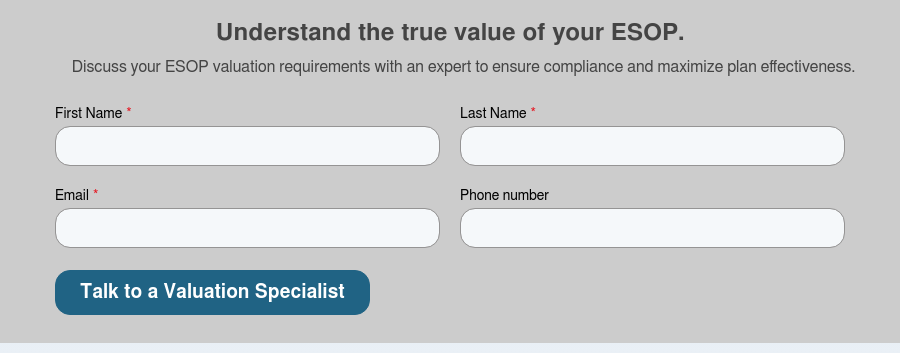Industry Trends
Largest Transactions Closed
- Target
- Buyer
- Value($mm)
Last updated: October 2025
As employee stock ownership plan (ESOP) liquidity strategies become an increasingly popular means for owners to exit their companies, a growing number of ESOP valuations are falling under U.S. Department of Labor (DOL) scrutiny. To provide assurance that the consideration paid for the stock of a company is no more than fair market value (FMV), a valuation of the company should be performed when the interest is sold to the ESOP and on an annual basis thereafter.1 Whether you’re a selling shareholder or an ESOP trustee, this article addresses common ESOP valuation mistakes that should be avoided during the appraisal.
There is no statutory mandate requiring due diligence, but the DOL has historically focused on issues concerning inadequate due diligence during the appraisal process. The valuation report should demonstrate and document that the appraiser conducted sufficient due diligence. The FMV of the shares can be questioned if valuation best practices are not followed.
During the due diligence process, an appraiser researches and analyzes your company’s overall health and profitability. A proper valuation examines the company’s historical performance and how it compares to the broader industry and the economy as a whole. The analysis should also consider your company’s financial situation and existing corporate structure. This includes a comprehensive review of your ESOP repurchase obligations, which may significantly affect future cash flows and valuations.
Your valuation firm should safeguard the information it gathers and review it in a manner that adequately meets valuation standards and guidance. The appraiser will require access to confidential information such as corporate documents, legal agreements, tax returns, audited financial statements, loan agreements, and details of any pending or threatened litigation.
Further, the valuation firm should discuss with your senior management any abnormalities in the historical operations, such as swings in cash, working capital, debt obligations, revenues, and expenses indicated in the financial statements.
If you’re considering an exit, you can find additional insight from PCE on what to expect during the due diligence process here: “Want a Successful ESOP? Avoid These Top 7 Mistakes”. For ESOP fiduciaries, recent settlements between the DOL and ESOP trustees provide an archive of valuable lessons regarding best practices to consider during the valuation process.
A company’s projections are a driving force of a business appraisal. In a 2015 interview, Timothy D. Hauser, the DOL’s Deputy Assistant Secretary for Program Operations of the Employee Benefits Security Administration (EBSA) discussed the use of unsupportable projections with ESOP valuations as a chronic problem. He stated:
People need to think hard and perform some level of scrutiny related to the projections. And in the cases we bring, we just don’t see that. We just see management projections getting plugged right into the ESOP appraisal without a critical review. Everybody moves on and does their math based on these management projections without “kicking the tires.”
Using unsupported forecasts and assumptions naturally leads to inaccurate opinions of value; a simple disclaimer in the appraisal is insufficient. In its report, the valuation firm should document the reasonableness of your forecasts.
When adjustments are applied to your company’s historical or projected financial metrics, the business appraisal should also document and explain why they were made. Avoiding common ESOP valuation mistakes can ensure that these adjustments are accurate, justified, and defensible. Adjustments can include those made for costs that are not directly related to generating revenue and profitability such as those for an owner’s personal expenses that are run through the company, or nonrecurring or extraordinary expenses for one-time items.
The DOL has heavily scrutinized blind reliance on management-prepared projections in ESOP valuations. For the benefit of all parties, it is crucial that forecasts be based on sound reasoning, e.g., assumptions supported by historical performance, industry growth trends, and current backlog. The appraiser’s failure to adequately address optimistic growth, unrealistic operating margins, customer or vendor concentration, owner compensation, capital expenditures, and working capital requirements may have a material impact on your company’s valuation if not considered appropriately.
Appraisers use three generally accepted valuation approaches to determine the value of a business enterprise: the asset (or cost) approach, income approach, and the market approach. Their selection of the appropriate valuation method(s) depends on a variety of factors such as growth, cyclicality of the business, and availability of guideline public companies, along with many other factors.
An asset (or cost) approach provides an indication of value to the equity holders by determining the net asset value of the company. This may be appropriate for distressed companies. However, for most ESOP companies that are expected to operate for the foreseeable future, a combination of the income approach and the market approach should be considered in determining the value of the ESOP shares.
Under the income approach, value is determined by using the future earnings capacity of the company. Depending on whether a single-period cash flow or a multiyear cash flow projection is used, an appraiser determines an appropriate capitalization rate or discount rate that considers the risk in achieving those future cashflows. Determining whether a single-period or a multiyear projection is appropriate is based on the specifics of the company being valued. A company expecting significant growth and improving margins over the next several years would likely not be valued using a single-period cash flow. Alternatively, a company that experiences consistent revenue growth and consistent margins might be well suited for a single-period cash flow, but what is that single-period cash flow based on? An experienced appraiser will discuss these questions with management and carefully consider them when using an income approach.
When using a market approach, an appraiser may look to guideline public companies and/or guideline merged and acquired companies that operate in similar industries to derive valuation multiples. To provide a reliable indication of value, the guideline companies used under this approach should be carefully selected in terms of comparability, but also the market multiples applied to the financial metrics of the subject company must be apples to apples.
Each company is unique, and no matter which valuation approach is used, each company must be analyzed carefully. There is a common phrase—past performance is no guarantee of future results. While this is a legal statement required of asset management firms, it is also sound advice; further, it is vitally important for appraisers to consider this in their valuation analyses. No one can simply assume that a company’s future performance will be consistent with the past few years, nor can an appraiser assume that all companies in the same industry perform the same and that pricing multiples will be the same, year after year after year. When concluding to value, an appraiser should carefully consider as many valuation approaches as possible and document why certain methods were employed and why other methods were discarded.
Another common valuation mistake that can occur during the annual valuation is ignoring the dilutive nature of warrants and stock appreciation rights (SARs) granted at the time of the ESOP transaction. Warrants and SARs are financial instruments with characteristics similar to stock options, as they provide the holders the appreciation in value from the time of the grant until it is exercised at a future date.
The dilutive nature of these instruments should be considered annually so that the price per share properly reflects all potential dilution in the share price of the company. If the strike price of these instruments is less than the FMV of the ESOP shares, how does an appraiser treat this when determining the ESOP share price? Some appraisers might treat these equity instruments as being “out of the money” and therefore assume they have little to no impact on the ESOP shares’ value. If these same equity instruments do not expire for many years, however, what about the future? These types of instruments have optionality, meaning they could very likely end up “in the money” in the very near future and, as a result, cause significant dilution to the ESOP shares. Each company’s equity structure is unique as to the ownership and the number of shares, warrants, and SARs. This equity structure must be carefully considered when determining the fair market value of the ESOP shares. Transparency is crucial, and the methods and assumptions considered when factoring in the dilutive impact of warrants and SARs should be clearly noted in the valuation analysis.
Whether you’re a business owner contemplating an ESOP sale or an ESOP trustee, your appraiser should be experienced in ESOP-specific issues and be able to provide guidance in order to potentially reduce your exposure to litigation. The valuation report should sufficiently address the risks to the ESOP and include various analyses and models to assess the company’s financial situation and future performance. Finally, the appraiser should be qualified and be up to date on the latest releases regarding DOL proceedings that involve breaches of fiduciary duties to the ESOP. One of the biggest mistakes a valuation firm can make is not learning from the mistakes of others.
Accurately valuing your ESOP is critical to ensuring regulatory compliance and long-term sustainability. Our seasoned valuation experts provide precise, defensible ESOP valuations, helping your company confidently navigate Department of Labor scrutiny and fiduciary responsibilities.
With our expert valuation services, you'll gain:
Fill out the form below to speak with an ESOP valuation specialist today.

Valuation
Orlando Office
407-621-2140 (direct)
rpearl@pcecompanies.com
Connect
407-621-2140 (direct)
407-621-2199 (fax)
